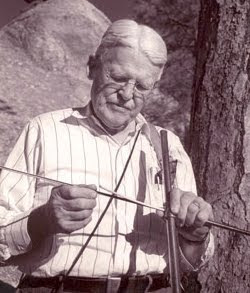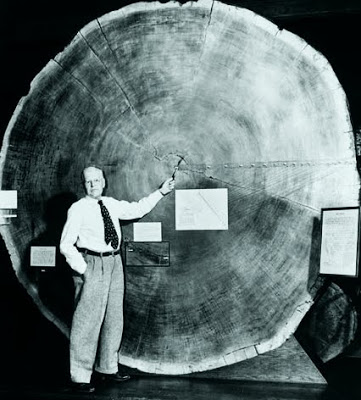Philosophy
 Andrew Ellicott Douglass
Andrew Ellicott Douglass
July 5th, 1867 to March 20th, 1962

Minnesota State University · Mankato, Minnesota...
Andrew Douglass was an American astronomer who's major accomplishment was perfecting the dendrochronology. When he was 27 and working at the Lowell Observatory at Flagstaff, Arizona, Douglass discovered a possible relationship between climate and plant growth. He then began recording the annual rings of near-by pines and Douglas firs. In 1911 he found matching records among trees felled around 50 miles to the southwest which prompted his study of the great Sequoias. When viewing a cross section of a tree, it was shown in certain species that wide rings were produced during wet years, and narrow rings were produced during dry years. Because tree-ring size is a record of past rainfall, it also reflects food supply in certain areas.
Douglass coined the term "dendrochronology," meaning tree-ring dating. Between 1919 and 1936, he wrote Climate Cycles and Tree Growth (3 vols.). His work done in the study of tree rings is now an invaluable method for archaeologists to date prehistoric remains. Douglass was first associated with archaeology in 1909 when Clark Wissler, of the American Museum of Natural History, linked him with the Archer M. Huntington Survey of the Southwest. In 1918, Wissler arranged for Douglass to receive the nine beam sections from Aztec Ruin and Pueblo Bonito so he could begin cross-dating these two famous ruins. Finally, the missing link to his studies came from an unstable beam that was extracted from the Whipple Ruin in Show Low, Arizona. That beam bridged the gap between living tree-ring chronology, and archaeological tree-ring chronology, and was an exciting moment in scientific discovery.
It takes a great deal of time and space to be able to study hundreds of samples and in a letter to the President of the University, Douglass expressed the need for a tree-ring research facility. He noted that without more assistance from the university, the status of being the top tree-ring research facility would be an immense lost. His letter resulted in a laboratory for tree-ring research. The many principles of dendrochronology discovered by Douglass, are used and studied today in many universities. The Laboratory of Tree-Ring Research, initiated by Douglass, is now a division of the College of Arts and Sciences. It has the world's largest accumulation of tree-ring specimens from living trees and age-old timbers.
Douglass wrote a total of 159 articles, many of which focus upon the cyclic phenomena or tree-rings. He received wide recognition for his accomplishments and several awards including appointment as research associate to the Carnegie Institution of Washington, designation of a life member to the National Geographic Society and nomination for the 1931 award of $2500 from the Research Corporation of New York.
A. E. Douglass [Wikipedia]
Andrew Ellicott Douglass and the Role of the Giant Sequoia in the Development of Dendrochronology by Stephen E. Nash
- Rush - On The Origin Of Specious, Religion Family Tree
One of the most useful tools Darwin bequeathed to us is the phylogenetic tree of life. Part of the reason this is a great tool is that it can help us visualize virtually any genealogical relationship in which some version of the mechanism of natural selection...
- Those Rare Trees Of Age
INTERNATIONAL YEAR OF FORESTS My colleague Tim sent me some information and a photo of the "Homon Sugi" on Japan's Yaku Island. The estimated age of this tree is 7,200 years. This made me wonder what the oldest living things on Earth are. Well,...
- August Kekulé...father Of Organic Chemistry
Friedrich August Kekulé von Stradonitz September 7th, 1829 to July 13th, 1896 (Friedrich) August Kekulé von Stradonitz was a German chemist who devised the ring structure of carbon atoms in organic molecules. Although at first intending to study...
- "franklinia Alatamaha" Tree
International Year of Biodiversity What's that...its a very special tree that has never been seen in the wild since 1803. The tree was named by two brothers, American botanists John Bartram [March 23rd, 1699] and William. All Franklinias today are...
- Saturn Loses Rings On Christmas Morning--naw
A Christmas treat via compliments of Saturn. So get up before sunrise and with the aid of a telescope [which might be under the tree] view a Saturn with nearly no rings. And, at that early hour, you might meet "the man". "Saturn's Crazy Christmas...
Philosophy
Andrew Ellicott Douglass...astronomer and dendrochronologist
 Andrew Ellicott Douglass
Andrew Ellicott DouglassJuly 5th, 1867 to March 20th, 1962

Minnesota State University · Mankato, Minnesota...
Andrew Douglass was an American astronomer who's major accomplishment was perfecting the dendrochronology. When he was 27 and working at the Lowell Observatory at Flagstaff, Arizona, Douglass discovered a possible relationship between climate and plant growth. He then began recording the annual rings of near-by pines and Douglas firs. In 1911 he found matching records among trees felled around 50 miles to the southwest which prompted his study of the great Sequoias. When viewing a cross section of a tree, it was shown in certain species that wide rings were produced during wet years, and narrow rings were produced during dry years. Because tree-ring size is a record of past rainfall, it also reflects food supply in certain areas.
Douglass coined the term "dendrochronology," meaning tree-ring dating. Between 1919 and 1936, he wrote Climate Cycles and Tree Growth (3 vols.). His work done in the study of tree rings is now an invaluable method for archaeologists to date prehistoric remains. Douglass was first associated with archaeology in 1909 when Clark Wissler, of the American Museum of Natural History, linked him with the Archer M. Huntington Survey of the Southwest. In 1918, Wissler arranged for Douglass to receive the nine beam sections from Aztec Ruin and Pueblo Bonito so he could begin cross-dating these two famous ruins. Finally, the missing link to his studies came from an unstable beam that was extracted from the Whipple Ruin in Show Low, Arizona. That beam bridged the gap between living tree-ring chronology, and archaeological tree-ring chronology, and was an exciting moment in scientific discovery.
It takes a great deal of time and space to be able to study hundreds of samples and in a letter to the President of the University, Douglass expressed the need for a tree-ring research facility. He noted that without more assistance from the university, the status of being the top tree-ring research facility would be an immense lost. His letter resulted in a laboratory for tree-ring research. The many principles of dendrochronology discovered by Douglass, are used and studied today in many universities. The Laboratory of Tree-Ring Research, initiated by Douglass, is now a division of the College of Arts and Sciences. It has the world's largest accumulation of tree-ring specimens from living trees and age-old timbers.
Douglass wrote a total of 159 articles, many of which focus upon the cyclic phenomena or tree-rings. He received wide recognition for his accomplishments and several awards including appointment as research associate to the Carnegie Institution of Washington, designation of a life member to the National Geographic Society and nomination for the 1931 award of $2500 from the Research Corporation of New York.
A. E. Douglass [Wikipedia]
Andrew Ellicott Douglass and the Role of the Giant Sequoia in the Development of Dendrochronology by Stephen E. Nash
- Rush - On The Origin Of Specious, Religion Family Tree
One of the most useful tools Darwin bequeathed to us is the phylogenetic tree of life. Part of the reason this is a great tool is that it can help us visualize virtually any genealogical relationship in which some version of the mechanism of natural selection...
- Those Rare Trees Of Age
INTERNATIONAL YEAR OF FORESTS My colleague Tim sent me some information and a photo of the "Homon Sugi" on Japan's Yaku Island. The estimated age of this tree is 7,200 years. This made me wonder what the oldest living things on Earth are. Well,...
- August Kekulé...father Of Organic Chemistry
Friedrich August Kekulé von Stradonitz September 7th, 1829 to July 13th, 1896 (Friedrich) August Kekulé von Stradonitz was a German chemist who devised the ring structure of carbon atoms in organic molecules. Although at first intending to study...
- "franklinia Alatamaha" Tree
International Year of Biodiversity What's that...its a very special tree that has never been seen in the wild since 1803. The tree was named by two brothers, American botanists John Bartram [March 23rd, 1699] and William. All Franklinias today are...
- Saturn Loses Rings On Christmas Morning--naw
A Christmas treat via compliments of Saturn. So get up before sunrise and with the aid of a telescope [which might be under the tree] view a Saturn with nearly no rings. And, at that early hour, you might meet "the man". "Saturn's Crazy Christmas...
